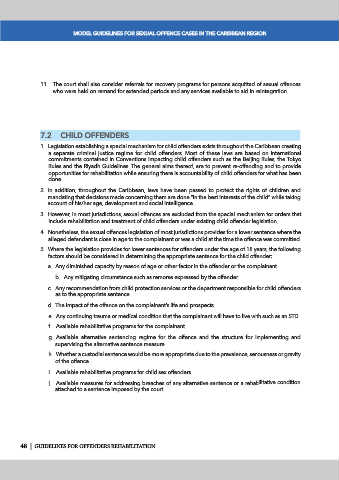Page 648 - Magistrates Conference 2019
P. 648
MODEL GUIDELINES FOR SEXUAL OFFENCE CASES IN THE CARIBBEAN REGION
11. The court shall also consider referrals for recovery programs for persons acquitted of sexual offences
who were held on remand for extended periods and any services available to aid in reintegration.
7.2 CHILD OFFENDERS
1. Legislation establishing a special mechanism for child offenders exists throughout the Caribbean creating
a separate criminal justice regime for child offenders. Most of these laws are based on international
commitments contained in Conventions impacting child offenders such as the Beijing Rules, the Tokyo
Rules and the Riyadh Guidelines. The general aims thereof, are to prevent re-offending and to provide
opportunities for rehabilitation while ensuring there is accountability of child offenders for what has been
done.
2. In addition, throughout the Caribbean, laws have been passed to protect the rights of children and
mandating that decisions made concerning them are done “in the best interests of the child” while taking
account of his/her age, development and social intelligence.
3. However, in most jurisdictions, sexual offences are excluded from the special mechanism for orders that
include rehabilitation and treatment of child offenders under existing child offender legislation.
4. Nonetheless, the sexual offences legislation of most jurisdictions provides for a lower sentence where the
alleged defendant is close in age to the complainant or was a child at the time the offence was committed.
5. Where the legislation provides for lower sentences for offenders under the age of 18 years, the following
factors should be considered in determining the appropriate sentence for the child offender:
a. Any diminished capacity by reason of age or other factor in the offender or the complainant.
b. Any mitigating circumstance such as remorse expressed by the offender.
c. Any recommendation from child protection services or the department responsible for child offenders
as to the appropriate sentence.
d. The impact of the offence on the complainant’s life and prospects.
e. Any continuing trauma or medical condition that the complainant will have to live with such as an STD.
f. Available rehabilitative programs for the complainant.
g. Available alternative sentencing regime for the offence and the structure for implementing and
supervising the alternative sentence measure.
h. Whether a custodial sentence would be more appropriate due to the prevalence, seriousness or gravity
of the offence.
i. Available rehabilitative programs for child sex offenders.
j. Available measures for addressing breaches of any alternative sentence or a rehabilitative condition
attached to a sentence imposed by the court.
48 | GUIDELINES FOR OFFENDERS REHABILITATION

